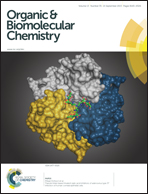Calix[4]arene triazole-linked pyrene: click synthesis, assembly on graphene oxide, and highly sensitive carbaryl sensing in serum†
Abstract
A fluorescent calix[4]arene triazole-linked pyrene (CP) was carefully designed and synthesized via click chemistry. The modification of CP with graphene oxide (GO) by a simple non-covalent interaction strategy is presented. Further inspection by electrochemical impedance spectroscopy reveals that the CP-GO could exhibit a very high supramolecular recognition for carbaryl, in particular in serum samples with a nanomolar concentration detection. Additionally, it is easy to directly observe macroscopic recognition by the contact angle, and expand practical applications.
![Graphical abstract: Calix[4]arene triazole-linked pyrene: click synthesis, assembly on graphene oxide, and highly sensitive carbaryl sensing in serum](/en/Image/Get?imageInfo.ImageType=GA&imageInfo.ImageIdentifier.ManuscriptID=C5OB01388G&imageInfo.ImageIdentifier.Year=2015)

 Please wait while we load your content...
Please wait while we load your content...